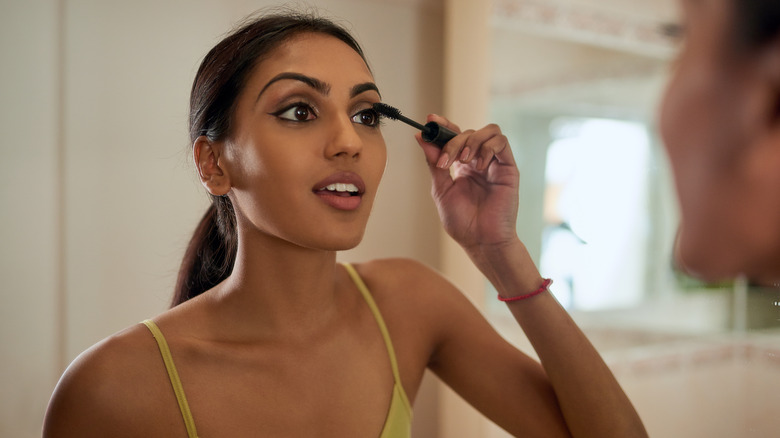How To Use Your Eye Color To Help Determine Your Skin's Undertone
The color of your skin is made up of what you can see on the surface, the skin tone, and what lies beneath, the undertone. While most of us look to the skin tone — fair, light, medium, or dark — to identify our shade, for makeup artists, the skin's undertone matters too. Unlike our skin tone, undertones don't change with time, sun exposure, or age. They are classified into three groups: cool, warm, and neutral.
If you've read up on the subject, you probably already know that there are a few easy ways to figure out your skin's undertones. Most experts would tell you to perform the white T-shirt or white paper test, where you hold up the crisp white material against your face and see how your skin looks in relation to it. If there's a rosy tint to your skin when compared to the white sheet of paper, you have a cool tone. If your skin appears yellowish, then you've got a warm undertone. If gray or green are the hues your skin is radiating, then you have a neutral undertone. Looking at your veins helps too. As pro makeup artist Daniel Martin shared with Byrdie, "You have cool undertones if you can see blue veins in your skin. If your veins appear green on the skin (olive), you're warm. Neutral is a mixture of both warm and cool undertones." But did you know that eye color could help determine your undertone too?
Here's how someone's eye color and undertone might be connected
Eye color is largely determined by the amount of melanin we have in our irises. Melanin is also what gives our hair and skin its hue. Brown is the most common eye color in the world, while green is the least common. Did you know that much like our skin's undertone, our eye color doesn't change as we age (unless of course we develop certain health conditions that alter its hue)?
Just like a sunburn can tell you about your skin's undertone, so can the color of your eyes, although it can't be the sole or final determinant. Makeup artist Robert Sesnek told Byrdie, "Eye and hair color can have any skin undertone in it, but as a generalization, deeper skin tones and deeper eye color usually tend to have warmer undertones while very fair skin and lighter eyes tend to have neutral or cool undertones."
So if you've got green, golden-brown, hazel, or amber-hued eyes, you likely have a warm undertone, and if you have blue, dark brown, or gray-colored eyes, this could mean a cooler undertone. Determining your skin's undertone based on just your eye color is probably not a good idea though, so try doing all other recommended tests if you want to arrive at a more conclusive result.
Why figuring out your skin's undertone is useful
You might think that just knowing the color on the surface of your skin is enough, but your undertone plays a very important role too. This is especially true when it comes to makeup and clothing.
As organic makeup artist Noleen Sliney shared on her website, knowing what your undertone is could be the difference between looking washed out or refreshed when it comes to your beauty regime. "For example, if you have a warm undertone to your skin, then choosing warm colors and shades that have warm undertones to them will enhance your complexion and give a rejuvenated, refreshed, and brighter look to your complexion," she explained.
When it comes to clothing, cooler or neutral undertones look best in cooler colors like blue, purple, and green, and those with warmer skin undertone should opt for oranges, reds, and yellows. This doesn't mean that cooler tones can't embrace brighter colors though. If you're looking to add more variety, stay with pale yellows, whites, or even rose reds. For warmer undertones, earthy hues are also a great choice — so think brown, peach, amber, and even gold. Having a neutral undertone means you have a lot more room for play with clothing choices. In fact, you can take inspiration from either end of the spectrum and determine what colors you like best.

